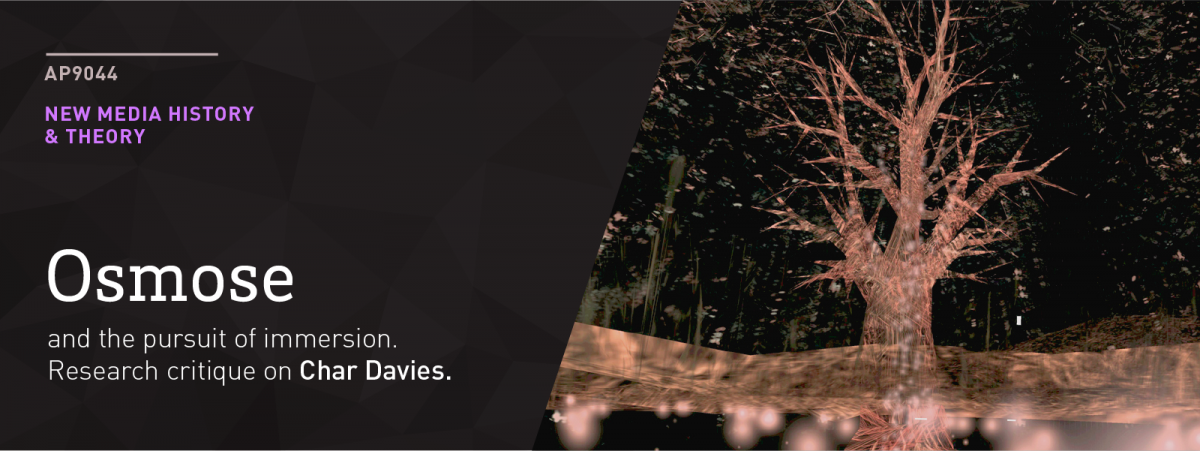Osmose by Char Davies is an example of a media art work that uses virtual reality to craft a fully immersive experience for its audience. Going beyond establishing a visual outcome, the artwork employs a multi-sensory approach to successfully transport viewers into the artist’s imagined space. The unique interaction method centered around breathing, as well as the use of a head-mounted display create a sense of tangibility that embeds the immersants deep into an otherwise foreign and unrealistic space that feels real.
In that regard, Osmose may be seen as pioneering attempt at realizing Ivan Sutherland’s vision that was penned in his essay ‘The Ultimate Display’ thirty years prior to the creation of this work. In it, Sutherland postulated that as technology got better, humans would be more capable of designing all encompassing sensory interfaces that would appear to simulate our reality to a point where “a computer can control the existence of matter”. While highly ambitions and visionary, the statement does align with how technology has progressed over the last 50 years since it was written. As a society, we strive to create computer systems and interfaces that remove the intermediary layer with which we manipulate media, and have tried to place the user as close to the content as possible with regard to the user experience. The ultimate goal then, is to march towards “complete immersion”.
Sutherland also discusses the idea of familiarity and how that affects the pursuit and uses of the theoretical ultimate display. He posits that being able to recreate experiences that one is already familiar with in real life would help to increase the perceived immersion in this “ultimate display”. In his essay ‘Virtual Environments’, Scott Fisher mirrors this line of thought by explaining that “for most people, duplicating reality is an assumed […] goal” for digital imaging technology. While the display might be useful in perfectly recreating the reality we are all familiar with, the display could also be used to help us discover new alternate realities with rules that we are not familiar with. While Sutherland uses the example of possibly exploring the physical properties of quantum mechanics to further human understanding, exploiting such displays for a more poetic and artistic outcome is also reasonable. Davies uses Osmose to allow her viewers to experience a new reality that would have been other difficult to reconcile with something as static as a painting.
Historically, art has always been communicated to others on a mediated platform. A painting is a summation of an artists internal experiences and believes that are then repackaged and visually represented for the consumption of another individual. The experience becomes largely external to the original thought and intent of the artist; it is consumed second-hand. As Fischer puts it, the “abstracted second-hand knowledge is often more generalized and concentrated” but lacks the “balance and completeness of experience.” First-hand experience then, becomes the defining factor as to how complete the encounter with a work becomes. Osmose brings this to the table by having the immersants experience first-hand, the imagined space just as the artist would have in her head during the conceptualizing of this work. The artist is provided the opportunity to externalize their thoughts in a more tangible fashion and viewers are able to step into the artist’s mind and form their own conclusions from that experience.
One could argue that the crucial element that ties all of this together is the way in which locomotion is controlled within the world of Osmose. By having her immersants’ breath patterns tie directly to how they move within the world, Davies is able to successfully marry a real-world physical experience (breathing and the tangible principles of buoyancy) to an imagined new space with it’s own rules in a way that is both familiar and awe-inspiring at the same time. This was the key to the unprecedented immersion that viewers of the work felt and perhaps, the way to continue approaching immersion in the field of media art.

